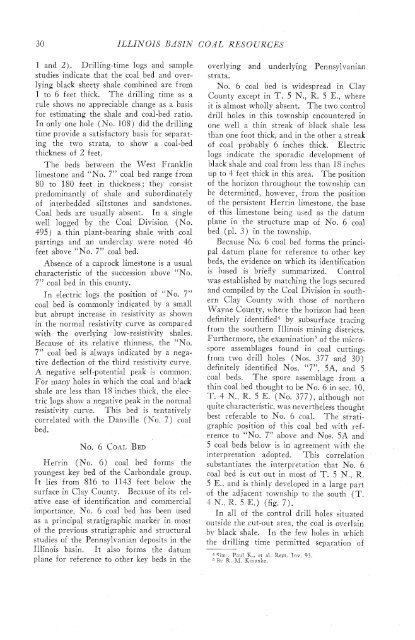subsurface geology and coal resources of the pennsylvanian system ...
subsurface geology and coal resources of the pennsylvanian system ...
subsurface geology and coal resources of the pennsylvanian system ...
You also want an ePaper? Increase the reach of your titles
YUMPU automatically turns print PDFs into web optimized ePapers that Google loves.
30 ILLINOIS BASIN COAL RESOURCES<br />
1 <strong>and</strong> 2). Drilling-time logs <strong>and</strong> sample<br />
studies indicate that <strong>the</strong> <strong>coal</strong> bed <strong>and</strong> overlying<br />
black sheety shale combined are from<br />
I to 6 feet thick. The drilling time as a<br />
rule shows no appreciable change as a basis<br />
for estimating <strong>the</strong> shale <strong>and</strong> <strong>coal</strong>-bed ratio.<br />
In only one hole (No. 108) did <strong>the</strong> drilling<br />
time provide a satisfactory basis for separating<br />
<strong>the</strong> two strata, to show a <strong>coal</strong>-bed<br />
thickness <strong>of</strong> 2 feet.<br />
The beds between <strong>the</strong> West Franklin<br />
limestone <strong>and</strong> '"0. 7" <strong>coal</strong> bed range from<br />
80 to I80 feet in thickness; <strong>the</strong>y consist<br />
predominantly <strong>of</strong> shale <strong>and</strong> subordinately<br />
<strong>of</strong> interbedded siltstones 2nd s<strong>and</strong>stones.<br />
Coal beds are usually absent. In a single<br />
well logged by <strong>the</strong> Coal Division (No.<br />
495) a thin plant-bearing shale with <strong>coal</strong><br />
partings <strong>and</strong> an underclay were noted 16<br />
feet above "No. 7" <strong>coal</strong> bed.<br />
Absence <strong>of</strong> a caprock limestone is a usual<br />
characteristic <strong>of</strong> <strong>the</strong> succession above "No.<br />
7" <strong>coal</strong> bed in this county.<br />
In electric logs <strong>the</strong> position <strong>of</strong> "No. 7"<br />
<strong>coal</strong> bed is commonly indicated by a small<br />
but abrupt increase in resistivity as shown<br />
in <strong>the</strong> normal resistivity curve as compared<br />
with <strong>the</strong> overlying low-resistivity shales.<br />
Because <strong>of</strong> its relative thinness, <strong>the</strong> "No.<br />
7" <strong>coal</strong> bed is always indicated bj7 a negative<br />
deflection <strong>of</strong> <strong>the</strong> third ~esistivity curve,<br />
A negative self-potential peak is common.<br />
For many holes in ~vhich <strong>the</strong> <strong>coal</strong> <strong>and</strong> b!ack<br />
shale are less than 18 inches thick, <strong>the</strong> electric<br />
logs show a negative peak in <strong>the</strong> normal<br />
resistivity curve. This bed is tentatively<br />
correlated with <strong>the</strong> Danville (No. 7) <strong>coal</strong><br />
bed.<br />
No. 6 COAL BED<br />
Herrin (No. 6) <strong>coal</strong> bed forms <strong>the</strong><br />
youngest key bed <strong>of</strong> <strong>the</strong> Carbondale group.<br />
It lies from 816 to 1113 feet below <strong>the</strong><br />
surface in Clay County. Because <strong>of</strong> its relative<br />
ease <strong>of</strong> identification <strong>and</strong> commercial<br />
importance, No. 6 <strong>coal</strong> bed has been used<br />
as a principal stratigraphic marker in most<br />
<strong>of</strong> <strong>the</strong> previous stratigraphic <strong>and</strong> structural<br />
studies <strong>of</strong> <strong>the</strong> Pennsylvanian deposits in <strong>the</strong><br />
Illinois basin. It also forms <strong>the</strong> datum<br />
plane for reference to o<strong>the</strong>r key beds in <strong>the</strong><br />
overlying <strong>and</strong> underlying Pennsylvanian<br />
strata.<br />
No. 6 <strong>coal</strong> bed is widespread in Clay<br />
County except in T. 5 N., R. 5 E., where<br />
it is almost wholly absent. The two control<br />
drill holes in this township encountered in<br />
one well a thin streak <strong>of</strong> black shale less<br />
than one foot thick, <strong>and</strong> in <strong>the</strong> o<strong>the</strong>r a streak<br />
<strong>of</strong> <strong>coal</strong> probably 6 inches thick. Electric<br />
logs indicate <strong>the</strong> sporadic development <strong>of</strong><br />
black shale <strong>and</strong> <strong>coal</strong> from less than 18 inches<br />
up to 4 feet thick in this area. The position<br />
<strong>of</strong> <strong>the</strong> horizon throughout <strong>the</strong> township can<br />
be determined, however, from <strong>the</strong> position<br />
<strong>of</strong> <strong>the</strong> persistent Herrin limestone, <strong>the</strong> base<br />
<strong>of</strong> this limestone being used as <strong>the</strong> datum<br />
plane in <strong>the</strong> structure map <strong>of</strong> No. 6 <strong>coal</strong><br />
bed (pl. 3) in <strong>the</strong> township.<br />
Because No. 6 <strong>coal</strong> bed forms <strong>the</strong> principal<br />
datum plane for reference to o<strong>the</strong>r key<br />
beds, <strong>the</strong> evidence on which its identification<br />
is based is briefly summarized. Control<br />
was established by matching <strong>the</strong> logs secured<br />
2nd compiled by <strong>the</strong> Coal Division in sou<strong>the</strong>rn<br />
Clay County with those <strong>of</strong> nor<strong>the</strong>rn<br />
tVayne County, where <strong>the</strong> horizon had been<br />
definitely identified4 by <strong>subsurface</strong> tracing<br />
from <strong>the</strong> sou<strong>the</strong>rn Illinois mining districts.<br />
Fur<strong>the</strong>rmore, <strong>the</strong> examination5 <strong>of</strong> <strong>the</strong> microspore<br />
assemblages found in <strong>coal</strong> cuttings<br />
from two drill holes (Nos. 377 <strong>and</strong> 30)<br />
definitely identified Nos. "7", $A, <strong>and</strong> 5<br />
<strong>coal</strong> beds. The spore assemblage from a<br />
thin <strong>coal</strong> bed thought to be No. 6 in sec. 10,<br />
'1'. 4 N., R. 5 E. (No. 377), although not<br />
quite characteristic, was never<strong>the</strong>less thought<br />
best referable to No. 6 <strong>coal</strong>. The stratigraphic<br />
position <strong>of</strong> this <strong>coal</strong> bed with reference<br />
to "No. 7" above <strong>and</strong> Nos. 5A <strong>and</strong><br />
5 <strong>coal</strong> beds below is in agreement with <strong>the</strong><br />
interpretation adopted. This correlation<br />
substantiates <strong>the</strong> interpretation that No. 6<br />
<strong>coal</strong> bed is cut out in most <strong>of</strong> T. 5 N., R.<br />
5 E., <strong>and</strong> is thinly developed in a large part<br />
<strong>of</strong> <strong>the</strong> adjacent township to <strong>the</strong> south (T.<br />
4 N., R. 5 E.) (fig. 7).<br />
In all <strong>of</strong> <strong>the</strong> control drill holes situated<br />
outside <strong>the</strong> cut-out area, <strong>the</strong> <strong>coal</strong> is overlain<br />
bv black shale. In <strong>the</strong> few holes in which<br />
<strong>the</strong> drilling time permitted separatio~l <strong>of</strong><br />
Sim- Paul I
















